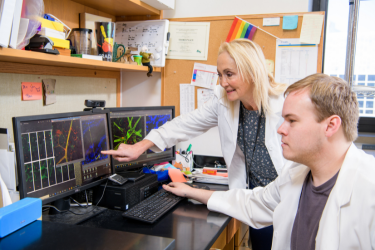 The research faculty within the UAB Department of Ophthalmology and Visual Sciences have demonstrated exceptional contribution to the field of ophthalmic research through their authorship of 94 publications in the 2023 fiscal year. These articles span 50 distinguished, peer-reviewed journals such as American Journal of Ophthalmology, British Journal of Ophthalmology, Investigative Ophthalmology & Visual Science, JAMA Ophthalmology, and more. This impressive body of work underscores the commitment to advancing ophthalmic knowledge and an impactful role in diverse scientific discussions. Their collective efforts further solidify the department’s reputation as a leader in vision research and innovation.
The research faculty within the UAB Department of Ophthalmology and Visual Sciences have demonstrated exceptional contribution to the field of ophthalmic research through their authorship of 94 publications in the 2023 fiscal year. These articles span 50 distinguished, peer-reviewed journals such as American Journal of Ophthalmology, British Journal of Ophthalmology, Investigative Ophthalmology & Visual Science, JAMA Ophthalmology, and more. This impressive body of work underscores the commitment to advancing ophthalmic knowledge and an impactful role in diverse scientific discussions. Their collective efforts further solidify the department’s reputation as a leader in vision research and innovation.
Demonstrating a steadfast commitment to advancing the understanding of vision health, the Department of Ophthalmology and Visual Sciences has achieved a significant milestone by securing over $10 million in research funding during the 2023 fiscal year. This achievement underscores the department’s dedication to expanding the frontiers of knowledge in the field of ophthalmology and driving pioneering discoveries to the forefront of eye care.
The Department of Ophthalmology and Visual Sciences is dedicated to a comprehensive range of research pursuits, encompassing critical aspects of vision health, including age-related macular degeneration (AMD), glaucoma, neuro-ophthalmology, ocular trauma, pediatric eye health, and the complexities of vision impairment and low vision. Through a dynamic fusion of innovation, state-of-the-art technology, and collaborative efforts, the UAB team has firmly established its commitment to addressing sight-threatening conditions and enhancing quality of life.
Notable recipients of funding awards include Massimo Fazio, Ph.D., whose project “Diagnostic Innovations in Glaucoma Study (DIGS): Glaucoma and Myopia” has been endowed through a collaboration with Dr. Linda Zangwill at the University of California, San Diego. This initiative holds the promise of enhancing our understanding of the complex relationship between glaucoma and myopia, potentially shedding light on novel diagnostic and therapeutic avenues.
Raphael Grytz, Ph.D., stands at the forefront of innovative research with his project “Scleral Remodeling in Myopia,” which is now backed by a substantial four-year, $2,232,240 grant from the National Eye Institute (NEI). Grytz aims to unravel the complex biomechanical intricacies of the eye, contributing crucial insights into myopia and its management.
Dawn DeCarlo, O.D., Ph.D., has been chosen to lead a clinical site for a federally funded clinical trial trough the Schepen Eye Research Institute as part of the project “Randomized Controlled Multicenter Clinical Trial of Multi-Periscopic Prism Glasses for Homonymous Hemianopia.” This effort, supported by the Schepens Eye Research Institute, holds significant potential to enhance the quality of life for individuals with homonymous hemianopia, a condition characterized by visual field loss in half of both eyes.
Maria Grant, M.D., has garnered funding of $2,129,733 over four years from the NEI for her groundbreaking project “Brain-Gut-Retina Axis in Diabetic Retinopathy.” This endeavor underscores the intricate interplay between different physiological systems and holds promise for advancing our understanding of diabetic retinopathy.
Gianfranco Bianco, Ph.D., has secured a two-year R21 grant totaling $428,850 from the NEI. Their pioneering work, titled “The Impact of Age-Related Vitreous Degeneration and Vitreous Replacement on Scleral Biomechanics,” explores the link between age-related vision loss and biomechanics.
Fazio has secured one year of funding from Heidelberg Engineering for his project, “The Effect of Imaging Parameters on Detected Retinal Blood Perfusion by Optical Coherence Tomography-Angiography.” This research aims to enhance our understanding of retinal blood perfusion using optical coherence tomography-angiography (OCTA) techniques.
Girkin, Fazio, and Alecia Gross, Ph.D., have garnered funding for their five-year R01 project titled “The Mechanotranscriptome of the Optic Nerve Head Following Acute Experimental Ocular Hypertension in Living Human Eyes,” which employs a groundbreaking ocular hypertension model to uncover the intricacies of the optic nerve head’s response to pressure changes.
The collaborative efforts of Grant and Julia Busik, Ph.D., from the Department of Physiology at Michigan State University, have been awarded a five-year award of $1,914,500 from the NEI. Their project, “Hematopoietic Cell Mobilization from Distinct Bone Marrow Compartments Following Retinal Injury,” explores the intricate connections between bone marrow and retinal injury.
Christine A. Curcio, Ph.D., is supported by a $71,720 grant from Novartis for her project “Human Ocular Tissues for Spatial Transcriptomics.” This endeavor holds the potential to unlock new dimensions of molecular discovery in AMD using a technology that links mRNA to specific locations in retina and choroid.
These significant funding awards collectively enable our researchers to continue their laboratory, clinical, and translational research efforts. Through innovation, cutting-edge technology, and collaboration, this remarkable team is committed to improving lives, pushing toward a future where blinding diseases are conquered and the gift of sight is preserved for all.